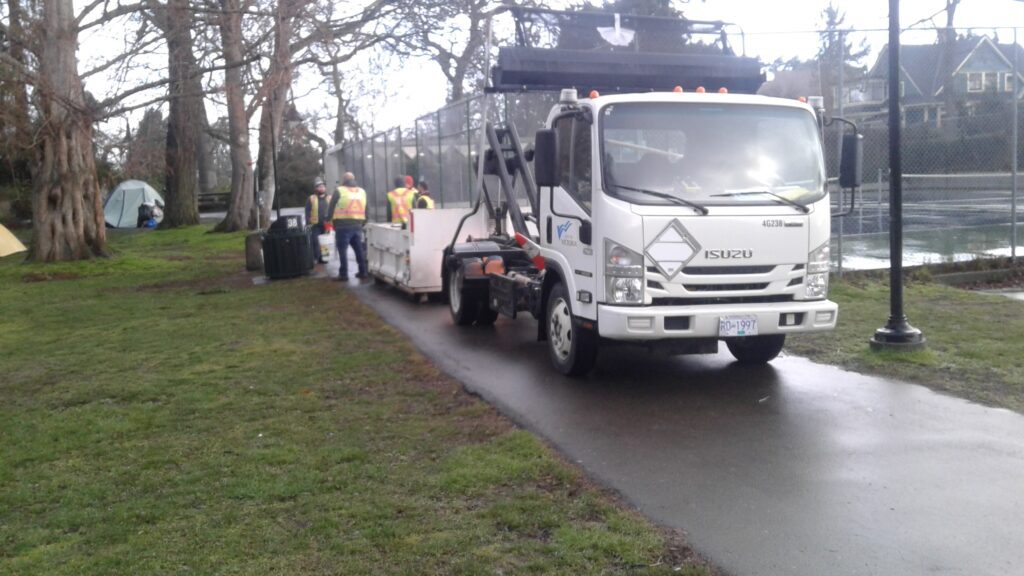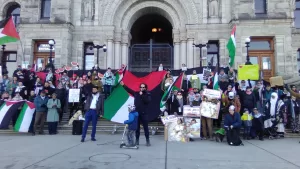The Emergency Weather Response Model Is Broken
While funding has been allocated to operate Emergency Weather Response shelters, chronic staff shortages has largely kept them closed. Time for a shift away from an emergency-based model?

City of Victoria employees at Stadacona Park, clearing an encampment first thing in the morning. In the end, this is the solution our governing bodies invest into in order to manage homelessness.
On Sunday, the Alliance to End Homelessness in the Capital Region has cancelled an Emergency Weather Alert, in spite of the fact Environment Canada had forecast low temperatures and rain, due to… staff shortages.
Indeed, none of the usual shelters, at the Salvation Army, St. John the Divine, or Rock Bay Landing, could open due to lack of staff. While chronic staff shortages have been reported before, to the best of my knowledge it was the first time this season it was so acute that none of them could open.
Furthermore, the Alliance exceeded its prerogative under the Assistance to Shelter Act, which makes no provision for outright cancelling an alert due to staff shortages; even then, the alert should have remained in effect, if only to warn the public of the impending risk.
I reached out to BC Housing for comment, which replied: “BC Housing has spoken to the Alliance to clarify the process around activating alerts (i.e., EWR alerts should only be issued once sites have staff confirmed to work and are able to open). BC Housing will document this by way of a letter to the Alliance to ensure there is clear understanding on the process.” This is nice, although it sort of misses the point.
BC Housing also acknowledges the system is broken: “Provincially, our non profits – including those in Victoria — are struggling with staffing issues. This is one reason why BCH is doing a review of the EWR program. The goal is to have a report this summer with recommendations for the 2023/24 winter season.”
The above is an understatement. For example, the City of Victoria was supposed to open multiple EWR shelters this season, and even posted 15 casual job openings in November, which I applied and even interviewed for. And yet these shelters never opened, due to staff shortages, which makes me wonder whether I’m the only one who applied for the job.
Outreach workers have proven scarce in recent years, and yet I am not aware of even one instance in which a regular overnight shelter failed to open due to staff shortages. In fact, I used to volunteer at Our Place Society’s main overnight shelter while it operated at the First Metropolitan United Church, and while I’m retroactively bound by a nondisclosure agreement in order to protect the confidentiality of family members, I can at least attest the shelter would always have enough staff to open.
The main issue, it would seem, is that filling casual positions is hard; few people can be expected to stand by the phone waiting for a call that isn’t likely to come on any given night. In contrast, it would be way easier to fill permanent, full-time positions by running those shelters every night, as opposed to an emergency-based model; as a bonus, less resources would have to be wasted clearing encampments erected by people without overnight shelter.
The alternative is to allocate funding that isn’t spent, on positions that don’t get filled and shelters that don’t open. And then wonder why unhoused people camp at Stadacona Park, to be woken first thing in the morning by an expensive crew of police officers, bylaw officers, and municipal workers treating their shelter like garbage.
The Alliance to End Homelessness in the Capital Region did not respond to a request for comment.
Discover more from Rulebreakers
Subscribe to get the latest posts sent to your email.



